Arai Report - Rd.9 German Grand Prix
German Grand Prix - Arai Report
14.07.2009

Thank you, as always, for your support over the weekend. The ninth race of the year marks the beginning of the second half of the 17-race 2009 F1 season. Located only about 100 km from our factory in Cologne, the Nürburgring was the site of this year’s German Grand Prix. As a team headquartered in Germany, the German Grand Prix is like a home race to us—on par with the Japanese Grand Prix. Without further ado, here is my report from the German Grand Prix, held for the first time in two years at the Nürburgring.
Our “second” home grand prix is a mid-/low-speed circuit; introducing new aero parts
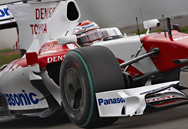 The team’s best-ever finish at the Nürburgring was P8 in 2005. In addition to being considered a home race for Panasonic Toyota Racing, the German GP is also Timo Glock’s home GP. The team brought new aero parts designed for the circuit, including a more complex front wing design.
The team’s best-ever finish at the Nürburgring was P8 in 2005. In addition to being considered a home race for Panasonic Toyota Racing, the German GP is also Timo Glock’s home GP. The team brought new aero parts designed for the circuit, including a more complex front wing design.
Instead of the usual two-week break, we had three weeks between the end of the British Grand Prix and the start of the German Grand Prix, the ninth race of the season. With a P5 qualifying at the Turkish GP and a P4 qualifying at the British GP, we had been steadily making our way back toward a podium finish since our last podium appearance at the Bahrain GP. Here at the German GP—which we consider to be our second home GP—we definitely wanted to turn in a performance to put us on the podium.
The Nürburgring consists of many low- and mid-speed corners, so we brought several new aerodynamic parts with us to the race. Specifically, we introduced a new front wing, and added new parts to the rear wing and both sides of the monocoque. As a team, we had yet to produce good results at the Nürburgring, but our team drivers (Jarno Trulli and Timo Glock) have traditionally performed well here, so we came to the circuit feeling good about making a strong result this year.
Altering our program to deal with unseasonably cool weather; ending Friday without finishing tire evaluations
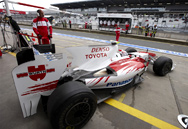 With unusually cool weather for July, the team struggled to secure tire grip. Even so, the team was able to prove the effectiveness of the new aero parts; Jarno reported after the last free practice on Friday that he was basically happy with the setup.
With unusually cool weather for July, the team struggled to secure tire grip. Even so, the team was able to prove the effectiveness of the new aero parts; Jarno reported after the last free practice on Friday that he was basically happy with the setup.
The weather during the week prior to the German GP was spectacular, with temperatures in excess of 20°C. Unfortunately, the weather took a sudden turn for the worse during race week. On Friday (the first day of the German GP race weekend), the ambient temperature was 10°C, with a track temperature of 14°C—conditions very similar to winter testing. We expected a lack of grip under these conditions, so we altered our program to begin with comparison testing of the new wing we brought with us to the circuit.
During the afternoon, the temperature was only 12°C—almost the exact same as the morning—but the track surface heated up to more than 20°C, allowing us to work on tire comparisons. The rain started to fall during the session, preventing us from doing long runs on the medium tire compound (the harder of the two compounds this week). Ultimately, we ended the first day of free practice without fully evaluating the tires.
Despite the circumstances, Jarno marked P5 on the time charts, and we were able to confirm the effectiveness of our new aero parts; we felt we had made some strong progress on Friday. Having said that, several teams that had been performing rather poorly to this point in the season showed increased pace, so we expected an even tougher fight during qualifying than usual.
Misreading the weather conditions; a completely unexpected qualifying result
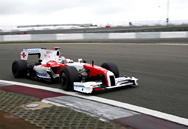 While the weather is certainly partly to blame, Timo noted that the cars had trouble getting heat into the tires during qualifying—a situation that also happened at the British GP three weeks prior. The team adopted measures to deal with the weather, but ultimately failed to advance to Q3.
While the weather is certainly partly to blame, Timo noted that the cars had trouble getting heat into the tires during qualifying—a situation that also happened at the British GP three weeks prior. The team adopted measures to deal with the weather, but ultimately failed to advance to Q3.
As far as we can tell from the lap times of the other teams in dry conditions during the final test period, we believe that both of the Panasonic Toyota Racing drivers could have advanced to the Q3 without any difficulties. Not getting even one car into Q3 came as a shock.
Our first miscalculation was having both drivers do their in-lap and first attack in Q1 on the harder set of tires (the “medium” compound). Only one other team chose to use medium tires, while the others opted for the softer “super-soft” compounds in their first time attacks. All of this left us on our back foot, in a position of playing defense.
Even with the miscalculation, Jarno was able to advance to Q2 after putting on the super-soft tires. Unfortunately, on-course circumstances prevented Timo from improving on his best time. With some time left in the session, we gambled and put Timo on a fresh set of tires, but the rain started to fall, keeping Timo from advancing to the next period.
At this point, Jarno was by himself in Q2, but we were at the mercy of the erratic weather. As soon as we put Jarno on dry tires and sent him onto the circuit, the rain started to fall. We brought him in to try another time attack on intermediate wet tires, but then the rain stopped, and the tires started to degrade quickly. We considered bringing Jarno back to the pits right away, but it was hard to tell what the weather was going to do next, so it took some time for us to come to a decision. During that time, our competitors changed to dry tires, with every car recording faster and faster times. We changed Jarno to dry weather tires for another attack lap, but then the rain started to fall again, preventing him from improving on his best time for the session.
Though we had a completely unexpected qualifying result at our home grand prix, we knew that anything could happen during the race. The weather report remained unchanged for Sunday, calling for a 50% to 70% chance of rain, so we revised our race strategy for our drivers, ready to respond to any condition.
Jarno is bumped on the first lap; Timo finishes just out of the points from a pit lane start
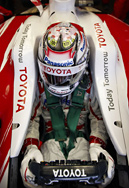 Timo, who had a specially designed helmet for the race, came up from the very back of the field to finish P9, just out of the points. Jarno recorded the second-fastest lap of the entire race, proving the strong pace of the TF109. Unfortunately, a collision early in the race was too much to overcome.
Timo, who had a specially designed helmet for the race, came up from the very back of the field to finish P9, just out of the points. Jarno recorded the second-fastest lap of the entire race, proving the strong pace of the TF109. Unfortunately, a collision early in the race was too much to overcome.
Three weeks ago at the British Grand Prix, our cars struggled off the starting grid. There was no such trouble this time around, and we launched smoothly. Unfortunately, Jarno lost position on track because of the poor start by a car in front. Then, Jarno was hit by another car between Turns 5 and 6. We didn’t see any data irregularities at first, so we kept Jarno out on the track, but there was a crack in the front wing end plate that forced us to call Jarno in on lap two. At this point, we fell back to nearly the last position, essentially ending Jarno’s chances of having a strong result.
Meanwhile, Timo was scheduled to start from the very last position on the grid (Timo qualified P19, and was assessed a penalty on top of that), so we made a drastic decision to change our strategy, and have Timo start the race from the pit lane. Timo was able to move through the race without any on-course incidents or car trouble, moving up to P9 and finishing barely out of the points.
The car that started one position behind Jarno finished the race at P4, so Jarno surely would have had a podium result if not for the troubles, making the race all the more disappointing for everyone at Panasonic Toyota Racing.
While we weren’t able to win any championship points at our “second” home grand prix, we were able to show everyone that our cars had plenty of pace. The Hungarian GP is at a circuit well-suited to Timo, who has a podium finish there. This will be the race where our results meet the high expectations of our team. We ask for your
continued support.

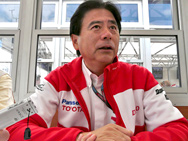 Noritoshi Arai at the Nürburgring. The German GP is considered the team’s “second” home grand prix. A misreading of the weather resulted in a disappointing qualifying, which in turn affected the race, and kept the team barely out of the points. Panasonic Toyota Racing will be shooting for a return to the podium at the Hungaroring, a circuit well suited to the team’s strengths!
Noritoshi Arai at the Nürburgring. The German GP is considered the team’s “second” home grand prix. A misreading of the weather resulted in a disappointing qualifying, which in turn affected the race, and kept the team barely out of the points. Panasonic Toyota Racing will be shooting for a return to the podium at the Hungaroring, a circuit well suited to the team’s strengths!